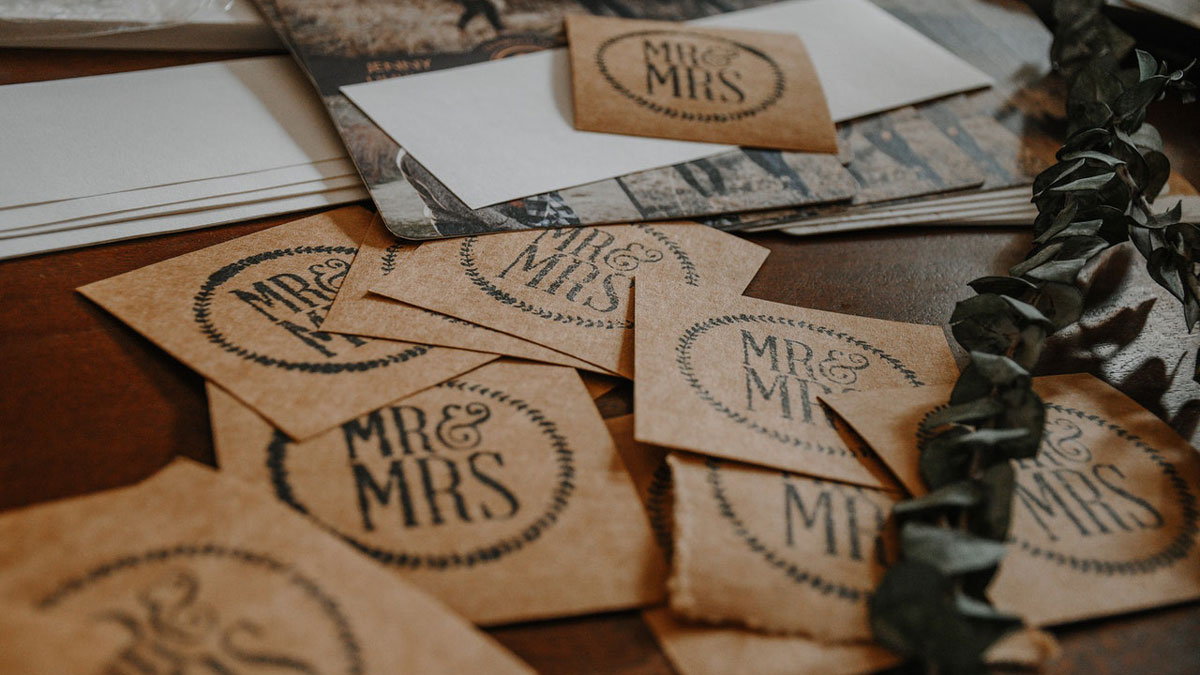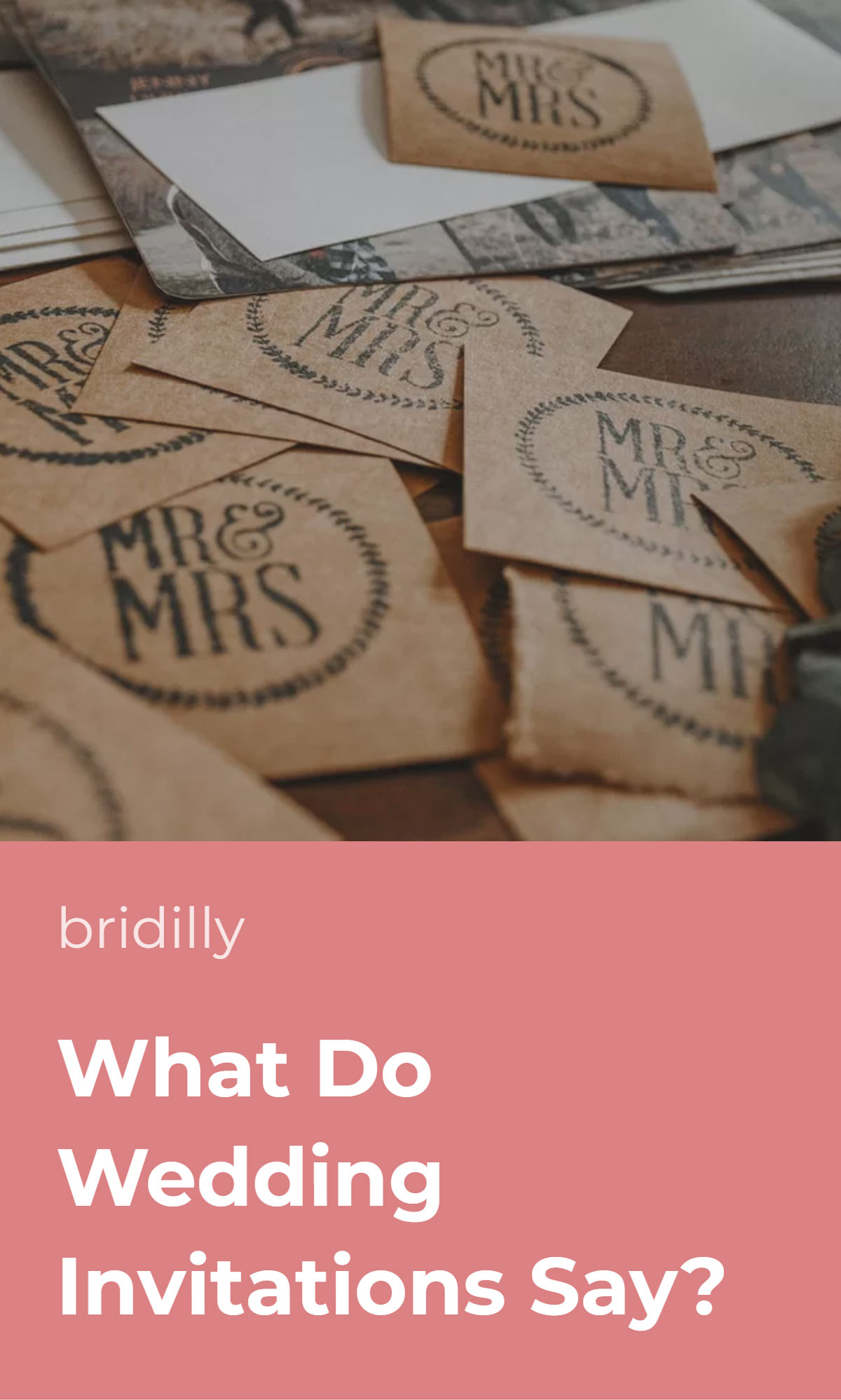Somewhere between designing wedding stationery, picking the right paper, and finalizing the guest list, every couple wonders – what do wedding invitations say?
Even the most creative people often struggle to word their wedding invitations, feeling slight embarrassment and awkwardness.
One may think that wedding invitation wording doesn’t provide the couple with such creative freedom as the color scheme or calligraphy, but this isn’t true.
Of course, traditional wedding invite wording follows specific etiquette guidelines, but there’s still room for expression. Furthermore, many couples nowadays prefer casual wording.
The goal is to word your wedding invitations clearly, concisely, and in line with the overall event’s style to deliver your message and avoid confusion.
Table of Contents [show]
The Host & Couple’s Names
Formal, traditional wedding invitations begin with defining the host or hosts. Typically, the hosts are either the bride’s parents, the groom’s parents, or the couple’s parents in collaboration with the newlyweds.
Regardless of who pays for the event, mentioning both sets of parents as the hosts is a golden rule of wedding invitation wording etiquette and a gracious way to express respect. It isn’t mandatory but preferred.
Never list the names according to who paid more. Instead, opt for alphabetical order or list the bride’s parents’ names first, then the groom’s.
If the wedding is a collaborative affair, you may word the first lines of the invitation as “Together with their parents, Sara and John request the pleasure of your company…” or similar.
However, many modern couples choose to foot the bill themselves. In this case, they may skip the parents’ names or include them as a sign of honor. In this case, you may have to change the wording a bit.
For example, you may write something along the lines of “Sara Miller, daughter of Mr. Adam Miler and Mrs. Iris Miller, together with John Smith, son of Mr. Jake Smith and Mrs. Karen Smith…”.
Similar wording also works if one of the parents is deceased, but the couple wants to honor their memory.
Suppose the groom’s mother is deceased; the invitations may state, “John Smith, son of Mr. Jake Smith and the late Karen Smith…”.
If the parents are divorced, a good tone is to list their names on separate lines. Note that you should list the names of all parents on different lines rather than only the divorced couple.
You may or may not mention the names of their new partners. If the newlyweds didn’t chip in for the wedding and the host line only mentions the parents, the following line is traditionally dedicated to the newlyweds’ names.
The bride’s name traditionally precedes the groom’s name. In the case of same-sex couples, the names may be arranged in alphabetical order or simply in a way that sounds better.
In the case of formal invitations issued by the couple’s parents, the newlyweds are traditionally referred to by full names along with the titles and middle names. Still, most couples nowadays prefer to go with a shorter version, e.g., simply “Sara and John.”
The Request To Attend
No one would forget to include a request to attend a wedding in an invitation – after all, that’s the primary purpose of this stationery piece. But how do you word a request to attend a wedding the right way?
The wording largely depends on the invitation tone, the couple’s personalities, and the overall wedding style.
Formal wedding invitation wording examples include “request the pleasure of your company,” “would love for you to join them at the celebration,” and “request the honor of your presence.”
Meanwhile, informal invitations may have a friendlier, more casual wording that reflects the event style. E.g., “invite you to share in their joy at their wedding” or “happily invite you to celebrate their wedding.”
Many couples find the traditional wedding invitation wording boring and go for unique, funny phrasing, e.g., “invite you to a ceremony followed by dinner, cocktails, and awkward but enthusiastic dancing.”
The best practice is to keep the request clear and concise, even if you opt for a traditional, old-fashioned wording.
The Date & Time
The host line and the attendance request serve merely a formal purpose rather than practical. Your guests will likely understand what’s the deal as soon as they see your and your partner’s name together on the invitation.
The date and time lines are where you begin to provide actually relevant information. However, not everyone knows how to write the date and time in wedding invitations correctly.
All information is traditionally written in full on formal wedding invites. For example, if you plan to get married on September 15 at 4:00 p.m., you should write “the fifteenth of September, at four o’clock in the afternoon.”
Always use “o’clock” when the time is on the hour. If it’s not, use hyphenation, e.g., “two-thirty” instead of “two thirty.” Always add “in the morning,” “noon,” “in the afternoon,” or “in the evening” after the time.”
Note that a formal way to spell half hours is “half after four o’clock” or “half four” rather than “four-thirty,” although the latter format may be easier to understand.
Optionally, you may also indicate the day of the week your wedding falls and the year. The general assumption is that a ceremony takes place on the nearest date, so the year isn’t mandatory.
You can use numerals for casual wedding invitations, for example, “September 15, at 4:00 p.m.” or simply “15.09 at 4:00 p.m.”.
The Location
The venue location is an essential piece of information on any wedding invitation.
Typically, invitations only include the venue name, town, and state to keep the wording clear and concise. However, the venue’s address is required if omitting it may confuse the guests.
The venue’s full address is also necessary if the wedding takes place at a private residence. ZIP code is not mandatory.
Alternatively, you may indicate only the venue name, town, and state on the invitation but add a link to your wedding website where you can provide additional details.
Don’t forget to mention the state because some town names in the U.S. aren’t unique. Always spell out the state name in full in traditional invites.
Note that you should indicate the location of your wedding ceremony, not the reception. If the reception takes place in a different venue, you can state the address on a separate line afterward.
Reception Information
The primary body of text ends with the ceremony address; any additional information is optional. However, most couples find listing reception information helpful for the guests.
You can share any relevant reception information on the main invitation cards or separate reception cards. For example, you may indicate the reception time if it doesn’t follow the ceremony immediately.
You may also include the reception address if it’s held in a different place than the ceremony. Other potential information to include is the reception format (cocktail, buffet, plated) or a humorous remark in the case of casual invites.
If your wedding has a theme, mention it on the reception information line unless it’s a surprise.
Dress Code
You may or may not include the dress code on your wedding invitations. Sometimes, the dress code is apparent from the wedding invitation wording style, venue, and reception type. For this reason, aligning the invitation wording with the event style is vital.
For example, a backyard wedding requires smart casual attire, a cocktail reception – a semi-formal dress, and a wedding at a luxurious castle venue presumes a black-tie dress code.
If you use formal wording for a casual family event, your guests may get confused.
If the dress code isn’t evident from other invitation details, indicating it is a good tone, especially if your wedding has a black-tie dress code. Otherwise, your guests may pick the wrong attire and feel uncomfortable.
The dress code is traditionally written on the right bottom corner or in the bottom center of the main invitation card or anywhere on a separate reception card. Alternatively, you may skip it on the invites and indicate it on your wedding website.
How to write a dress code on wedding invitations depends on the overall wording style and your preference. Suppose the dress code is formal; you can write “Dress Formal,” “Dress Code: Formal,” or “Formal Attire (Black Tie Optional).”
Capitalize each word in the dress code line in traditional invites. Ensure that your guests can easily google the dress code if they don’t understand it. In other words, use clear and widely accepted wording.
Always mention the season and dress code if part of your event is outside. For instance, write “Formal Winter Attire” if you plan an outdoor winter ceremony.
You may kindly request your guests to wear a specific attire color or style if you plan a themed wedding. However, it shouldn’t be mandatory since not everyone will be willing to buy a dress for one time.
RSVP
Most couples include a separate RSVP response card along with their invitations. An RSVP is necessary to gather information to finalize the guest list and communicate with vendors.
However, if you find using so much paper wasteful or are low on budget, you’re free to ditch the response card and include an RSVP request at the bottom of your invitations. The RSVP request always has a deadline.
According to the wedding invitation etiquette, the couple pays for RSVP postage, so you should include a stamped envelope with the invitation. If you don’t want to pay for the postage, add a link to your RSVP website.















No Comments Add one
Leave a Comment